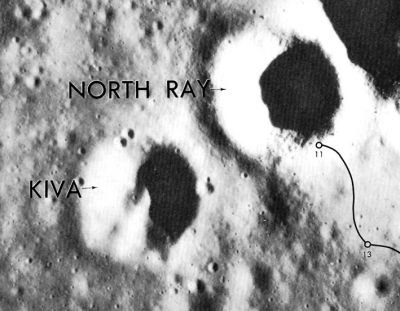Difference between revisions of "Kiva"
(Created page with "<div id="content_view" class="wiki" style="display: block"> =Kiva (Apollo 16 site craterlet name)= {| class="wiki_table" | Lat: 8.6°S, Long: 15.5°E, Diam: 1 km, Depth: k...") |
|||
| Line 3: | Line 3: | ||
{| class="wiki_table" | {| class="wiki_table" | ||
| | | | ||
| − | Lat: 8.6°S, Long: 15.5°E, Diam: 1 km, Depth: km, [ | + | Lat: 8.6°S, Long: 15.5°E, Diam: 1 km, Depth: km, [[R%C3%BCkl%2045|Rükl: 45]]<br /> |
|} | |} | ||
<div id="toc"> | <div id="toc"> | ||
| Line 11: | Line 11: | ||
[http://www.lpod.org/coppermine/thumbnails.php?album=search&type=full&search=Kiva LPOD Photo Gallery] [http://www.lpi.usra.edu/resources/lunar_orbiter/bin/srch_nam.shtml?Kiva%7C0 Lunar Orbiter Images] [http://www.lpi.usra.edu/resources/apollo/search/feature/?feature=Kiva Apollo Images]<br /> <br /> | [http://www.lpod.org/coppermine/thumbnails.php?album=search&type=full&search=Kiva LPOD Photo Gallery] [http://www.lpi.usra.edu/resources/lunar_orbiter/bin/srch_nam.shtml?Kiva%7C0 Lunar Orbiter Images] [http://www.lpi.usra.edu/resources/apollo/search/feature/?feature=Kiva Apollo Images]<br /> <br /> | ||
==Maps== | ==Maps== | ||
| − | ''([ | + | ''([[LAC%20zone|LAC zone]] 78D2)'' [http://www.lpi.usra.edu/resources/mapcatalog/LAC/lac78/ LAC map] [http://www.lpi.usra.edu/resources/mapcatalog/usgs/I546/ Geologic map] [http://www.lpi.usra.edu/resources/mapcatalog/LM/lm78/ LM map] [http://www.lpi.usra.edu/resources/mapcatalog/LTO/lto78d2_1/ LTO map] [http://www.lpi.usra.edu/resources/mapcatalog/topophoto/78D2S1/ Topophotomap 78D2/S1]<br /> <br /> |
==Description== | ==Description== | ||
| − | The [ | + | The [[Landing%20Site%20Name|Landing Site Name]] "Kiva" is plotted on [http://www.lpi.usra.edu/resources/mapcatalog/LPST/78d2s2/ Site Traverses chart 78D2S2].<br /> <br /> |
==Description: Wikipedia== | ==Description: Wikipedia== | ||
(no Wikipedia page for Apollo 16's crater '''Kiva''').<br /> <br /> | (no Wikipedia page for Apollo 16's crater '''Kiva''').<br /> <br /> | ||
| Line 19: | Line 19: | ||
It is perhaps possible to observe '''Kiva''' through very powerful telescopes, or to make digital webcam photographs of it (also through powerful telescopes). '''Kiva''' has the same diameter as its northeastern neighbour '''North Ray Crater''', and should be observed during the hours when there's enough shadow on its inner slopes (as seen in the orbital photograph above). The albedo of '''Kiva''' is rather low, and because of this it is not observable during Full Moon. '''North Ray Crater''' on the other hand is a very easy observer's target just before, during, and after Full Moon!<span class="membersnap">- [http://www.wikispaces.com/user/view/DannyCaes [[Image:DannyCaes-lg.jpg|16px|DannyCaes]]] [http://www.wikispaces.com/user/view/DannyCaes DannyCaes] <small>Apr 25, 2010</small></span><br /> <br /> | It is perhaps possible to observe '''Kiva''' through very powerful telescopes, or to make digital webcam photographs of it (also through powerful telescopes). '''Kiva''' has the same diameter as its northeastern neighbour '''North Ray Crater''', and should be observed during the hours when there's enough shadow on its inner slopes (as seen in the orbital photograph above). The albedo of '''Kiva''' is rather low, and because of this it is not observable during Full Moon. '''North Ray Crater''' on the other hand is a very easy observer's target just before, during, and after Full Moon!<span class="membersnap">- [http://www.wikispaces.com/user/view/DannyCaes [[Image:DannyCaes-lg.jpg|16px|DannyCaes]]] [http://www.wikispaces.com/user/view/DannyCaes DannyCaes] <small>Apr 25, 2010</small></span><br /> <br /> | ||
==Nomenclature== | ==Nomenclature== | ||
| − | Astronaut-named feature, [ | + | Astronaut-named feature, [[Apollo%2016%20site|Apollo 16 site]].<br /> '''Kiva:''' southwest of '''North Ray crater''', named after the Pueblo Indian architectural structure which is usually round.<br /> <br /> |
==LPOD Articles== | ==LPOD Articles== | ||
<br /> | <br /> | ||
Revision as of 15:54, 15 April 2018
Contents
Kiva (Apollo 16 site craterlet name)
|
Lat: 8.6°S, Long: 15.5°E, Diam: 1 km, Depth: km, Rükl: 45 |
Table of Contents
[#Kiva (Apollo 16 site craterlet name) Kiva (Apollo 16 site craterlet name)]
[#Kiva (Apollo 16 site craterlet name)-Images Images]
[#Kiva (Apollo 16 site craterlet name)-Maps Maps]
[#Kiva (Apollo 16 site craterlet name)-Description Description]
[#Kiva (Apollo 16 site craterlet name)-Description: Wikipedia Description: Wikipedia]
[#Kiva (Apollo 16 site craterlet name)-Additional Information Additional Information]
[#Kiva (Apollo 16 site craterlet name)-Nomenclature Nomenclature]
[#Kiva (Apollo 16 site craterlet name)-LPOD Articles LPOD Articles]
[#Kiva (Apollo 16 site craterlet name)-Bibliography Bibliography]
 Apollo 16 Site Traverses Chart
Apollo 16 Site Traverses ChartImages
LPOD Photo Gallery Lunar Orbiter Images Apollo Images
Maps
(LAC zone 78D2) LAC map Geologic map LM map LTO map Topophotomap 78D2/S1
Description
The Landing Site Name "Kiva" is plotted on Site Traverses chart 78D2S2.
Description: Wikipedia
(no Wikipedia page for Apollo 16's crater Kiva).
Additional Information
It is perhaps possible to observe Kiva through very powerful telescopes, or to make digital webcam photographs of it (also through powerful telescopes). Kiva has the same diameter as its northeastern neighbour North Ray Crater, and should be observed during the hours when there's enough shadow on its inner slopes (as seen in the orbital photograph above). The albedo of Kiva is rather low, and because of this it is not observable during Full Moon. North Ray Crater on the other hand is a very easy observer's target just before, during, and after Full Moon!- DannyCaes DannyCaes Apr 25, 2010
Nomenclature
Astronaut-named feature, Apollo 16 site.
Kiva: southwest of North Ray crater, named after the Pueblo Indian architectural structure which is usually round.
LPOD Articles
Bibliography
David M. Harland: EXPLORING THE MOON, the Apollo expeditions.
Eric M. Jones: APOLLO LUNAR SURFACE JOURNAL (ALSJ).
This page has been edited 1 times. The last modification was made by - tychocrater tychocrater on Jun 13, 2009 3:24 pm - afx3u2